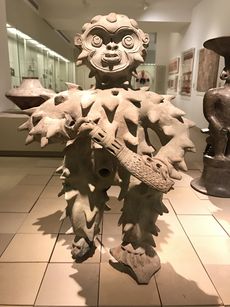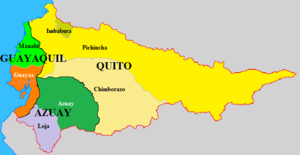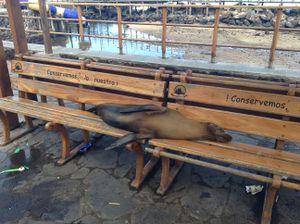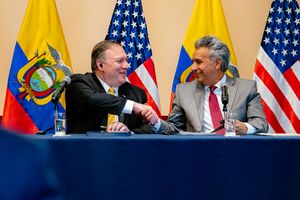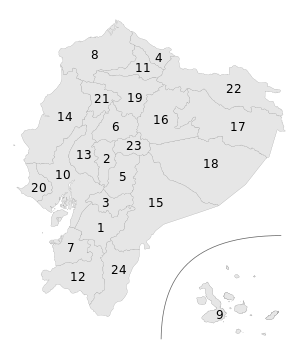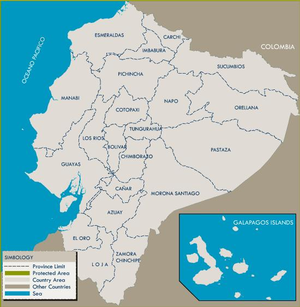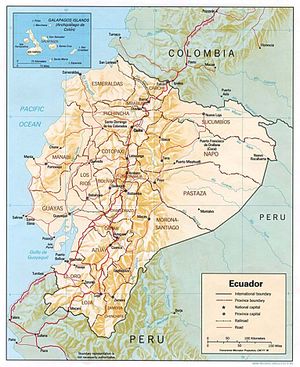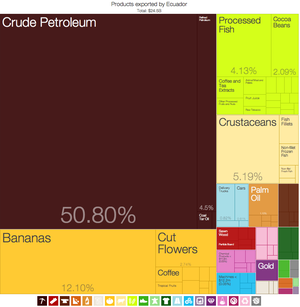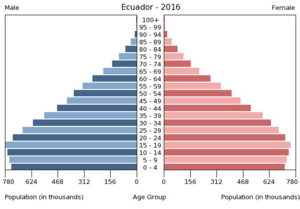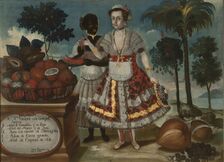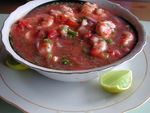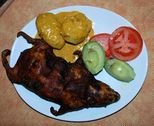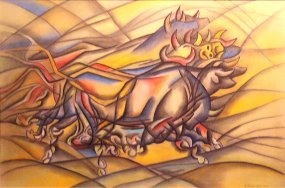الإكوادور
جمهورية الإكوادور | |
|---|---|
الشعار الحادي:
| |
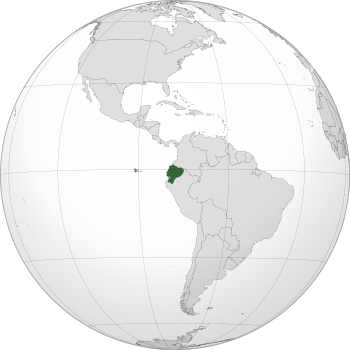 موقع الإكوادور (الأخضر الداكن) | |
| العاصمة | كيتو[1] 00°13′12″S 78°30′43″W / 0.22000°S 78.51194°W |
| أكبر مدينة | العاصمة |
| اللغات الرسمية | الإسپانية[2] |
| اللغات الإقليمية المعترف بها | الكيتشوا الشوار وغيرها "هي اللغات الرسمية للشعوب الأصلية"[3] |
| الجماعات العرقية (2010[4]) |
|
| الدين (2020)[5] |
|
| صفة المواطن | إكوادوري |
| الحكومة | جمهورية رئاسية مركزية |
• الرئيس | دانيال نوبوا |
| ألفريدو بوريرو | |
| التشريع | الجمعية الوطنية |
| الاستقلال | |
• أعلن | 10 أغسطس 1809 |
• عن إسپانيا | 24 مايو 1822 |
• عن كولومبيا الكبرى | 13 مايو 1830 |
• اعتراف إسپانيا | 16 فبراير 1840[6] |
| 5 يونيو 1895 | |
| 28 سبتمبر 2008 | |
| المساحة | |
• الإجمالية | 283.561 km2 (109.484 sq mi)[7] (رقم 73) |
• الماء (%) | 5 |
| التعداد | |
• تقدير 2022 | 17.289.554[8] (رقم 71) |
• إحصاء 2022 | 18.048,628[9] |
• الكثافة | 69/km2 (178.7/sq mi) (رقم 148) |
| ن.م.إ. (ق.ش.م.) | تقدير 2022 |
• الإجمالي | ▲229.815 دولار billion[10] (رقم 68) |
• للفرد | ▲ 12.763 دولار [10] (رقم 109) |
| ن.م.إ. (الإسمي) | تقدير 2022 |
• الإجمالي | ▲ 115.479 بليون دولار [10] (رقم 63) |
• للفرد | ▲$6,413[10] (رقم 95) |
| جيني (2020) | ▲ 47.3[11] high |
| م.ت.ب. (2021) | high · رقم 95 |
| العملة | الدولار الأمريكيb (USD) |
| التوقيت | UTC−5 / −6 (ECT / GALT) |
| صيغة التاريخ | dd/mm/yyyy |
| جانب السواقة | right |
| مفتاح الهاتف | +593 |
| النطاق العلوي للإنترنت | .ec |
| |
جمهورية الإكوادور (/ˈɛkwədɔːr/ (![]() استمع) EK-wə-dor; النطق الإسپاني: [ekwaˈðoɾ]؛ Quechua: Ikwayur؛ شوار: Ecuador أو Ekuatur)؛[13][14] ورسمياً جمهورية الإكوادور (إسپانية: República del Ecuador, والتي تعني حرفياً "جمهورية خط الإستواء"؛ Quechua: Ikwadur Ripuwlika; Shuar: Ekuatur Nunka),[15][16] هي بلد في شمال غرب أمريكا الجنوبية يمر فيها خط الاستواء. تحدها كولومبيا من الشمال وپيرو من الجنوب والشرق. تطل على المحيط الهادي من الغرب. تتبع البلاد مجموعة جزر گلاپاگوس التي تبعد عنها حوالي 965 كم إلى الغرب منها. العاصمة هي كيتو وگواياكيل هي أكبر مدينة.[17][18]
استمع) EK-wə-dor; النطق الإسپاني: [ekwaˈðoɾ]؛ Quechua: Ikwayur؛ شوار: Ecuador أو Ekuatur)؛[13][14] ورسمياً جمهورية الإكوادور (إسپانية: República del Ecuador, والتي تعني حرفياً "جمهورية خط الإستواء"؛ Quechua: Ikwadur Ripuwlika; Shuar: Ekuatur Nunka),[15][16] هي بلد في شمال غرب أمريكا الجنوبية يمر فيها خط الاستواء. تحدها كولومبيا من الشمال وپيرو من الجنوب والشرق. تطل على المحيط الهادي من الغرب. تتبع البلاد مجموعة جزر گلاپاگوس التي تبعد عنها حوالي 965 كم إلى الغرب منها. العاصمة هي كيتو وگواياكيل هي أكبر مدينة.[17][18]
كانت أراضي الإكوادور الحديثة ذات يوم موطنًا لمجموعة متنوعة من مجموعات الهنود الحمر التي تم دمجها تدريجياً في إمبراطورية الإنكا خلال القرن الخامس عشر. استعمرت إسبانيا المنطقة خلال القرن السادس عشر ، وحصلت على استقلالها في عام 1820 كجزء من كولومبيا الكبرى ، والتي ظهرت منها كدولة ذات سيادة في عام 1830. وينعكس إرث كلتا الإمبراطوريتين في تنوع سكان الإكوادور عرقياً ، مع وجود معظم 16.4 مليون شخص من الهجين ، يليهم أقليات كبيرة من الأوروبيين والهنود الأمريكيين والأفارقة. اللغة الإسبانية هي اللغة الرسمية ويتحدث بها غالبية السكان ، على الرغم من الاعتراف أيضًا بـ 13 لغة أمريكية هندية ، بما في ذلك كيتشوا و شوار.
دولة الإكوادور ذات السيادة هي جمهورية ديمقراطية ذات دخل متوسط مع اقتصاد نامٍ يعتمد بشكل كبير على السلع الأساسية ، أي البترول والمنتجات الزراعية. تحكمها جمهورية ديمقراطية رئاسية. واحدة من 18 دولة شديدة التنوع في العالم ، تستضيف الإكوادور العديد من النباتات والحيوانات المتوطنة ، مثل تلك الموجودة في جزر گالاباگوس. اعترافًا بتراثها البيئي الفريد ، يعد الدستور الجديد لعام 2008 أول دستور في العالم يعترف بحقوق الطبيعة أو حقوق النظام البيئي القابلة للتنفيذ قانونًا. كما أن لديها خامس أقل معدل جرائم قتل في الأمريكتين. بين عامي 2006 و 2016 ، انخفض معدل الفقر من 36.7٪ إلى 22.5٪ وبلغ نمو نصيب الفرد من إجمالي الناتج المحلي سنويًا 1.5٪ (مقارنة بـ 0.6٪ خلال العقدين الماضيين). في الوقت نفسه ، انخفضت التفاوتات ، وفقًا لقياس مؤشر جيني ، من 0.55 إلى 0.47.
التاريخ
 مقالات مفصلة: تاريخ الإكوادور
مقالات مفصلة: تاريخ الإكوادور- الشعوب الأصلية في الإكوادور
عصر ما قبل الإنكا
Various peoples had settled in the area of future Ecuador before the arrival of the Incas. The archeological evidence suggests that the Paleo-Indians' first dispersal into the Americas occurred near the end of the last glacial period, around 16,500–13,000 years ago. The first Indians who reached Ecuador may have journeyed by land from North and Central America or by boat down the Pacific Ocean coastline. Much later migrations to Ecuador may have come via the Amazon tributaries, others descended from northern South America, and others ascended from the southern part of South America through the Andes. They developed different languages while emerging as unique ethnic groups.
Even though their languages were unrelated, these groups developed similar groups of cultures, each based in different environments. The people of the coast developed a fishing, hunting, and gathering culture; the people of the highland Andes developed a sedentary agricultural way of life, and the people of the Amazon basin developed a nomadic hunting-and-gathering mode of existence.
Over time these groups began to interact and intermingle with each other so that groups of families in one area became one community or tribe, with a similar language and culture. Many civilizations arose in Ecuador, such as the Valdivia Culture and Machalilla Culture on the coast, the Quitus (near present-day Quito), and the Cañari (near present-day Cuenca). Each civilization developed its own distinctive architecture, pottery, and religious interests.
In the highland Andes mountains, where life was more sedentary, groups of tribes cooperated and formed villages; thus the first nations based on agricultural resources and the domestication of animals formed. Eventually, through wars and marriage alliances of their leaders, a group of nations formed confederations. One region consolidated under a confederation called the Shyris, which exercised organized trading and bartering between the different regions. Its political and military power came under the rule of the Duchicela blood-line.
فترة الإنكا

When the Incas arrived, they found that these confederations were so developed that it took the Incas two generations of rulers—Topa Inca Yupanqui and Huayna Capac—to absorb them into the Inca Empire. The native confederations that gave them the most problems were deported to distant areas of Peru, Bolivia, and north Argentina. Similarly, a number of loyal Inca subjects from Peru and Bolivia were brought to Ecuador to prevent rebellion. Thus, the region of highland Ecuador became part of the Inca Empire in 1463 sharing the same language.
In contrast, when the Incas made incursions into coastal Ecuador and the eastern Amazon jungles of Ecuador, they found both the environment and indigenous people more hostile. Moreover, when the Incas tried to subdue them, these indigenous people withdrew to the interior and resorted to guerrilla tactics. As a result, Inca expansion into the Amazon Basin and the Pacific coast of Ecuador was hampered. The indigenous people of the Amazon jungle and coastal Ecuador remained relatively autonomous until the Spanish soldiers and missionaries arrived in force. The Amazonian people and the Cayapas of Coastal Ecuador were the only groups to resist Inca and Spanish domination, maintaining their language and culture well into the 21st century.
الحكم الاسباني
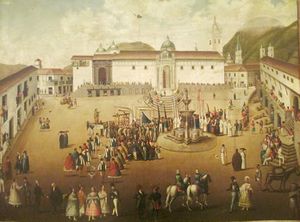
New infectious diseases such as smallpox, endemic to the Europeans, caused high fatalities among the Amerindian population during the first decades of Spanish rule, as they had no immunity. At the same time, the natives were forced into the encomienda labor system for the Spanish. In 1563, Quito became the seat of a real audiencia (administrative district) of Spain and part of the Viceroyalty of Peru and later the Viceroyalty of New Granada.
The 1797 Riobamba earthquake, which caused up to 40,000 casualties, was studied by Alexander von Humboldt, when he visited the area in 1801–1802.[19]
After nearly 300 years of Spanish rule, Quito was still a small city numbering 10,000 inhabitants. On August 10, 1809, the city's criollos called for independence from Spain (first among the peoples of Latin America). They were led by Juan Pío Montúfar, Quiroga, Salinas, and Bishop Cuero y Caicedo. Quito's nickname, "Luz de América" ("Light of America"), is based on its leading role in trying to secure an independent, local government. Although the new government lasted no more than two months, it had important repercussions and was an inspiration for the independence movement of the rest of Spanish America. August 10 is now celebrated as Independence Day, a national holiday.[20]
الاستقلال


On October 9, 1820, Guayaquil became the first city in Ecuador to gain its independence from Spain. Its inhabitants celebrated what is now Ecuador's official Independence Day on May 24, 1822. The rest of Ecuador gained its independence after Antonio José de Sucre defeated the Spanish Royalist forces at the Battle of Pichincha, near Quito. Following the battle, Ecuador joined Simón Bolívar's Republic of Gran Colombia, also including modern-day Colombia, Venezuela and Panama. In 1830, Ecuador separated from Gran Colombia and became an independent republic.
The 19th century was marked by instability for Ecuador with a rapid succession of rulers. The first president of Ecuador was the Venezuelan-born Juan José Flores, who was ultimately deposed, followed by several authoritarian leaders, such as Vicente Rocafuerte; José Joaquín de Olmedo; José María Urbina; Diego Noboa; Pedro José de Arteta; Manuel de Ascásubi; and Flores's own son, Antonio Flores Jijón, among others. The conservative Gabriel Garcia Moreno unified the country in the 1860s with the support of the Roman Catholic Church. In the late 19th century, world demand for cocoa tied the economy to commodity exports and led to migrations from the highlands to the agricultural frontier on the coast.
Ecuador abolished slavery and freed its black slaves in 1851.[21]
الثورة الليبرالية
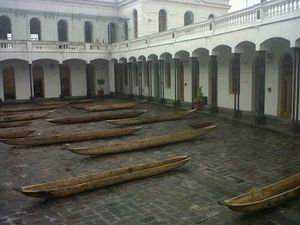
The Liberal Revolution of 1895 under Eloy Alfaro reduced the power of the clergy and the conservative land owners. This liberal wing retained power until the military "Julian Revolution" of 1925. The 1930s and 1940s were marked by instability and emergence of populist politicians, such as five-time President José María Velasco Ibarra.
فقدان الأقاليم المطالـَب بها منذ 1830
قالب:Campaignbox Ecuadorian-Peruvian
المزاعم الإقليمية القانونية للرئيس خوان خوسيه فلوريس
منذ انفصال الإكوادور عن كولومبيا في 13 مايو 1830، طالَب أول رؤسائها، الجنرال خوان خوسيه فلوريس، بالإقليم الذي كان يُسمى Real Audiencia of Quito, also referred to as the Presidencia of Quito. He supported his claims with Spanish Royal decrees or Real Cedulas, that delineated the borders of Spain's former overseas colonies. In the case of Ecuador, Flores-based Ecuador's de jure claims on the following cedulas - Real Cedula of 1563, 1739, and 1740; with modifications in the Amazon Basin and Andes Mountains that were introduced through the Treaty of Guayaquil (1829) which Peru reluctantly signed, after the overwhelmingly outnumbered Gran Colombian force led by Antonio José de Sucre defeated President and General La Mar's Peruvian invasion force in the Battle of Tarqui. In addition, Ecuador's eastern border with the Portuguese colony of Brazil in the Amazon Basin was modified before the wars of Independence by the First Treaty of San Ildefonso (1777) between the Spanish Empire and the Portuguese Empire. Moreover, to add legitimacy to his claims, on February 16, 1840, Flores signed a treaty with Spain, whereby Flores convinced Spain to officially recognize Ecuadorian independence and its sole rights to colonial titles over Spain's former colonial territory known anciently to Spain as the Kingdom and Presidency of Quito.
Ecuador during its long and turbulent history has lost most of its contested territories to each of its more powerful neighbors, such as Colombia in 1832 and 1916, Brazil in 1904 through a series of peaceful treaties, and Peru after a short war in which the Protocol of Rio de Janeiro was signed in 1942.
النضال من أجل الاستقلال
During the struggle for independence, before Peru or Ecuador became independent nations, a few areas of the former Vice Royalty of New Granada - Guayaquil, Tumbez, and Jaén - declared themselves independent from Spain. A few months later, a part of the Peruvian liberation army of San Martin decided to occupy the independent cities of Tumbez and Jaén with the intention of using these towns as springboards to occupy the independent city of Guayaquil and then to liberate the rest of the Audiencia de Quito (Ecuador). It was common knowledge among the top officers of the liberation army from the south that their leader San Martin wished to liberate present-day Ecuador and add it to the future republic of Peru, since it had been part of the Inca Empire before the Spaniards conquered it.
However, Bolívar's intention was to form a new republic known as the Gran Colombia, out of the liberated Spanish territory of New Granada which consisted of Colombia, Venezuela, and Ecuador. San Martin's plans were thwarted when Bolívar, with the help of Marshal Antonio José de Sucre and the Gran Colombian liberation force, descended from the Andes mountains and occupied Guayaquil; they also annexed the newly liberated Audiencia de Quito to the Republic of Gran Colombia. This happened a few days before San Martin's Peruvian forces could arrive and occupy Guayaquil, with the intention of annexing Guayaquil to the rest of Audiencia of Quito (Ecuador) and to the future republic of Peru. Historic documents repeatedly stated that San Martin told Bolivar he came to Guayaquil to liberate the land of the Incas from Spain. Bolivar countered by sending a message from Guayaquil welcoming San Martin and his troops to Colombian soil.
الاحتلال الپيروڤي لـ خاين، تومبس، و گواياكيل
In the south, Ecuador had de jure claims to a small piece of land beside the Pacific Ocean known as Tumbes which lay between the Zarumilla and Tumbes rivers. In Ecuador's southern Andes Mountain region where the Marañon cuts across, Ecuador had de jure claims to an area it called Jaén de Bracamoros. These areas were included as part of the territory of Gran Colombia by Bolivar on December 17, 1819, during the Congress of Angostura when the Republic of Gran Colombia was created. Tumbes declared itself independent from Spain on January 17, 1821, and Jaen de Bracamoros on June 17, 1821, without any outside help from revolutionary armies. However, that same year, 1821, Peruvian forces participating in the Trujillo revolution occupied both Jaen and Tumbes. Some Peruvian generals, without any legal titles backing them up and with Ecuador still federated with the Gran Colombia, had the desire to annex Ecuador to the Republic of Peru at the expense of the Gran Colombia, feeling that Ecuador was once part of the Inca Empire.
On July 28, 1821, Peruvian independence was proclaimed in Lima by the Liberator San Martin, and Tumbes and Jaen, which were included as part of the revolution of Trujillo by the Peruvian occupying force, had the whole region swear allegiance to the new Peruvian flag and incorporated itself into Peru, even though Peru was not completely liberated from Spain. After Peru was completely liberated from Spain by the patriot armies led by Bolivar and Antonio Jose de Sucre at the Battle of Ayacucho dated December 9, 1824, there was a strong desire by some Peruvians to resurrect the Inca Empire and to include Bolivia and Ecuador. One of these Peruvian Generals was the Ecuadorian-born José de La Mar, who became one of Peru's presidents after Bolivar resigned as dictator of Peru and returned to Colombia. Gran Colombia had always protested Peru for the return of Jaen and Tumbes for almost a decade, then finally Bolivar after long and futile discussion over the return of Jaen, Tumbes, and part of Mainas, declared war. President and General José de La Mar, who was born in Ecuador, believing his opportunity had come to annex the District of Ecuador to Peru, personally, with a Peruvian force, invaded and occupied Guayaquil and a few cities in the Loja region of southern Ecuador on November 28, 1828.
The war ended when a triumphant heavily outnumbered southern Gran Colombian army at Battle of Tarqui dated February 27, 1829, led by Antonio José de Sucre, defeated the Peruvian invasion force led by President La Mar. This defeat led to the signing of the Treaty of Guayaquil dated September 22, 1829, whereby Peru and its Congress recognized Gran Colombian rights over Tumbes, Jaen, and Maynas. Through protocolized meetings between representatives of Peru and Gran Colombia, the border was set as Tumbes river in the west and in the east the Maranon and Amazon rivers were to be followed toward Brazil as the most natural borders between them. However, what was pending was whether the new border around the Jaen region should follow the Chinchipe River or the Huancabamba River. According to the peace negotiations Peru agreed to return Guayaquil, Tumbez, and Jaén; despite this, Peru returned Guayaquil, but failed to return Tumbes and Jaén, alleging that it was not obligated to follow the agreements, since the Gran Colombia ceased to exist when it divided itself into three different nations - Ecuador, Colombia, and Venezuela.
فض گران كولومبيا
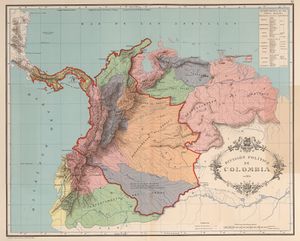
The Central District of the Gran Colombia, known as Cundinamarca or New Granada (modern Colombia) with its capital in Bogota, did not recognize the separation of the Southern District of the Gran Colombia, with its capital in Quito, from the Gran Colombian federation on May 13, 1830. After Ecuador's separation, the Department of Cauca voluntarily decided to unite itself with Ecuador due to instability in the central government of Bogota. The Venezuelan born President of Ecuador, the general Juan José Flores, with the approval of the Ecuadorian congress annexed the Department of Cauca on December 20, 1830, since the government of Cauca had called for union with the District of the South as far back as April 1830. Moreover, the Cauca region, throughout its long history, had very strong economic and cultural ties with the people of Ecuador. Also, the Cauca region, which included such cities as Pasto, Popayán, and Buenaventura, had always been dependent on the Presidencia or Audiencia of Quito.
Fruitless negotiations continued between the governments of Bogotá and Quito, where the government of Bogotá did not recognize the separation of Ecuador or that of Cauca from the Gran Colombia until war broke out in May 1832. In five months, New Granada defeated Ecuador due to the fact that the majority of the Ecuadorian Armed Forces were composed of rebellious angry unpaid veterans from Venezuela and Colombia that did not want to fight against their fellow countrymen. Seeing that his officers were rebelling, mutinying, and changing sides, President Flores had no option but to reluctantly make peace with New Granada. The Treaty of Pasto of 1832 was signed by which the Department of Cauca was turned over to New Granada (modern Colombia), the government of Bogotá recognized Ecuador as an independent country and the border was to follow the Ley de División Territorial de la República de Colombia (Law of the Division of Territory of the Gran Colombia) passed on June 25, 1824. This law set the border at the river Carchi and the eastern border that stretched to Brazil at the Caquetá river. Later, Ecuador contended that the Republic of Colombia, while reorganizing its government, unlawfully made its eastern border provisional and that Colombia extended its claims south to the Napo River because it said that the Government of Popayán extended its control all the way to the Napo River.
النضال لامتلاك حوض الأمازون
When Ecuador seceded from the Gran Colombia, Peru decided not to follow the treaty of Guayaquil of 1829 or the protocoled agreements made. Peru contested Ecuador's claims with the newly discovered Real Cedula of 1802, by which Peru claims the King of Spain had transferred these lands from the Viceroyalty of New Granada to the Viceroyalty of Peru. During colonial times this was to halt the ever-expanding Portuguese settlements into Spanish domains, which were left vacant and in disorder after the expulsion of Jesuit missionaries from their bases along the Amazon Basin. Ecuador countered by labeling the Cedula of 1802 an ecclesiastical instrument, which had nothing to do with political borders. Peru began its de facto occupation of disputed Amazonian territories, after it signed a secret 1851 peace treaty in favor of Brazil. This treaty disregarded Spanish rights that were confirmed during colonial times by a Spanish-Portuguese treaty over the Amazon regarding territories held by illegal Portuguese settlers.
Peru began occupying the defenseless missionary villages in the Mainas or Maynas region, which it began calling Loreto, with its capital in Iquitos. During its negotiations with Brazil, Peru stated that based on the royal cedula of 1802, it claimed Amazonian Basin territories up to Caqueta River in the north and toward the Andes Mountain range, depriving Ecuador and Colombia of all their claims to the Amazon Basin. Colombia protested stating that its claims extended south toward the Napo and Amazon Rivers. Ecuador protested that it claimed the Amazon Basin between the Caqueta river and the Marañon-Amazon river. Peru ignored these protests and created the Department of Loreto in 1853 with its capital in Iquitos which it had recently invaded and systematically began to occupy using the river systems in all the territories claimed by both Colombia and Ecuador. Peru briefly occupied Guayaquil again in 1860, since Peru thought that Ecuador was selling some of the disputed land for development to British bond holders, but returned Guayaquil after a few months. The border dispute was then submitted to Spain for arbitration from 1880 to 1910, but to no avail.
In the early part of the 20th century, Ecuador made an effort to peacefully define its eastern Amazonian borders with its neighbours through negotiation. On May 6, 1904, Ecuador signed the Tobar-Rio Branco Treaty recognizing Brazil's claims to the Amazon in recognition of Ecuador's claim to be an Amazonian country to counter Peru's earlier Treaty with Brazil back in October 23, 1851. Then after a few meetings with the Colombian government's representatives an agreement was reached and the Muñoz Vernaza-Suarez Treaty was signed July 15, 1916, in which Colombian rights to the Putumayo river were recognized as well as Ecuador's rights to the Napo river and the new border was a line that ran midpoint between those two rivers. In this way, Ecuador gave up the claims it had to the Amazonian territories between the Caquetá River and Napo River to Colombia, thus cutting itself off from Brazil. Later, a brief war erupted between Colombia and Peru, over Peru's claims to the Caquetá region, which ended with Peru reluctantly signing the Salomon-Lozano Treaty on March 24, 1922. Ecuador protested this secret treaty, since Colombia gave away Ecuadorian claimed land to Peru that Ecuador had given to Colombia in 1916.
In July 21, 1924, the Ponce-Castro Oyanguren Protocol was signed between Ecuador and Peru where both agreed to hold direct negotiations and to resolve the dispute in an equitable manner and to submit the differing points of the dispute to the United States for arbitration. Negotiations between the Ecuadorian and Peruvian representatives began in Washington on September 30, 1935. These negotiations were long and tiresome. Both sides logically presented their cases, but no one seemed to give up their claims. Then on February 6, 1937, Ecuador presented a transactional line which Peru rejected the next day. The negotiations turned into intense arguments during the next 7 months and finally on September 29, 1937, the Peruvian representatives decided to break off the negotiations without submitting the dispute to arbitration because the direct negotiations were going nowhere.
Four years later in 1941, amid fast-growing tensions within disputed territories around the Zarumilla River, war broke out with Peru. Peru claimed that Ecuador's military presence in Peruvian-claimed territory was an invasion; Ecuador, for its part, claimed that Peru had recently invaded Ecuador around the Zarumilla River and that Peru since Ecuador's independence from Spain has systematically occupied Tumbez, Jaen, and most of the disputed territories in the Amazonian Basin between the Putomayo and Marañon Rivers. In July 1941, troops were mobilized in both countries. Peru had an army of 11,681 troops who faced a poorly supplied and inadequately armed Ecuadorian force of 2,300, of which only 1,300 were deployed in the southern provinces. Hostilities erupted on July 5, 1941, when Peruvian forces crossed the Zarumilla river at several locations, testing the strength and resolve of the Ecuadorian border troops. Finally, on July 23, 1941, the Peruvians launched a major invasion, crossing the Zarumilla river in force and advancing into the Ecuadorian province of El Oro.
During the course of the Ecuadorian–Peruvian War, Peru gained control over part of the disputed territory and some parts of the province of El Oro, and some parts of the province of Loja, demanding that the Ecuadorian government give up its territorial claims. The Peruvian Navy blocked the port of Guayaquil, almost cutting all supplies to the Ecuadorian troops. After a few weeks of war and under pressure by the United States and several Latin American nations, all fighting came to a stop. Ecuador and Peru came to an accord formalized in the Rio Protocol, signed on January 29, 1942, in favor of hemispheric unity against the Axis Powers in World War II favouring Peru with the territory they occupied at the time the war came to an end.
The 1944 Glorious May Revolution followed a military-civilian rebellion and a subsequent civic strike which successfully removed Carlos Arroyo del Río as a dictator from Ecuador's government. However, a post-Second World War recession and popular unrest led to a return to populist politics and domestic military interventions in the 1960s, while foreign companies developed oil resources in the Ecuadorian Amazon. In 1972, construction of the Andean pipeline was completed. The pipeline brought oil from the east side of the Andes to the coast, making Ecuador South America's second largest oil exporter. The pipeline in southern Ecuador did nothing to resolve tensions between Ecuador and Peru, however.
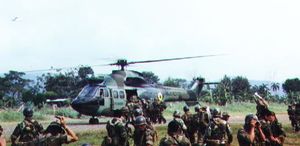
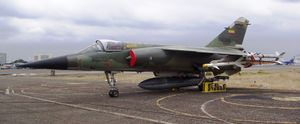
The Rio Protocol failed to precisely resolve the border along a little river in the remote Cordillera del Cóndor region in southern Ecuador. This caused a long-simmering dispute between Ecuador and Peru, which ultimately led to fighting between the two countries; first a border skirmish in January–February 1981 known as the Paquisha Incident, and ultimately full-scale warfare in January 1995 where the Ecuadorian military shot down Peruvian aircraft and helicopters and Peruvian infantry marched into southern Ecuador. Each country blamed the other for the onset of hostilities, known as the Cenepa War. Sixto Durán Ballén, the Ecuadorian president, famously declared that he would not give up a single centimeter of Ecuador. Popular sentiment in Ecuador became strongly nationalistic against Peru: graffiti could be seen on the walls of Quito referring to Peru as the "Cain de Latinoamérica", a reference to the murder of Abel by his brother Cain in the Book of Genesis.[22]
Ecuador and Peru signed the Brasilia Presidential Act peace agreement on October 26, 1998, which ended hostilities, and effectively put an end to the Western Hemisphere's longest running territorial dispute.[23] The Guarantors of the Rio Protocol (Argentina, Brazil, Chile, and the United States of America) ruled that the border of the undelineated zone was to be set at the line of the Cordillera del Cóndor. While Ecuador had to give up its decades-old territorial claims to the eastern slopes of the Cordillera, as well as to the entire western area of Cenepa headwaters, Peru was compelled to give to Ecuador, in perpetual lease but without sovereignty, 1 km2 (0.39 sq mi) of its territory, in the area where the Ecuadorian base of Tiwinza – focal point of the war – had been located within Peruvian soil and which the Ecuadorian Army held during the conflict. The final border demarcation came into effect on May 13, 1999 and the multi-national MOMEP (Military Observer Mission for Ecuador and Peru) troop deployment withdrew on June 17, 1999.[23]
الحكومات العسكرية (1972–79)
In 1972, a "revolutionary and nationalist" military junta overthrew the government of Velasco Ibarra. The coup d'état was led by General Guillermo Rodríguez and executed by navy commander Jorge Queirolo G. The new president exiled José María Velasco to Argentina. He remained in power until 1976, when he was removed by another military government. That military junta was led by Admiral Alfredo Poveda, who was declared chairman of the Supreme Council. The Supreme Council included two other members: General Guillermo Durán Arcentales and General Luis Leoro Franco. The civil society more and more insistently called for democratic elections. Colonel Richelieu Levoyer, Government Minister, proposed and implemented a Plan to return to the constitutional system through universal elections. This plan enabled the new democratically elected president to assume the duties of the executive office.
العودة للديمقراطية
Elections were held on April 29, 1979, under a new constitution. Jaime Roldós Aguilera was elected president, garnering over one million votes, the most in Ecuadorian history. He took office on August 10, as the first constitutionally elected president after nearly a decade of civilian and military dictatorships. In 1980, he founded the Partido Pueblo, Cambio y Democracia (People, Change, and Democracy Party) after withdrawing from the Concentración de Fuerzas Populares (Popular Forces Concentration) and governed until May 24, 1981, when he died along with his wife and the minister of defense, Marco Subia Martinez, when his Air Force plane crashed in heavy rain near the Peruvian border. Many people believe that he was assassinated by the CIA,[بحاجة لمصدر] given the multiple death threats leveled against him because of his reformist agenda, deaths in automobile crashes of two key witnesses before they could testify during the investigation, and the sometimes contradictory accounts of the incident.
Roldos was immediately succeeded by Vice President Osvaldo Hurtado, who was followed in 1984 by León Febres Cordero from the Social Christian Party. Rodrigo Borja Cevallos of the Democratic Left (Izquierda Democrática, or ID) party won the presidency in 1988, running in the runoff election against Abdalá Bucaram (brother in law of Jaime Roldos and founder of the Ecuadorian Roldosist Party). His government was committed to improving human rights protection and carried out some reforms, notably an opening of Ecuador to foreign trade. The Borja government concluded an accord leading to the disbanding of the small terrorist group, "¡Alfaro Vive, Carajo!" ("Alfaro Lives, Dammit!"), named after Eloy Alfaro. However, continuing economic problems undermined the popularity of the ID, and opposition parties gained control of Congress in 1999.

The emergence of the Amerindian population as an active constituency has added to the democratic volatility of the country in recent years. The population has been motivated by government failures to deliver on promises of land reform, lower unemployment and provision of social services, and historical exploitation by the land-holding elite. Their movement, along with the continuing destabilizing efforts by both the elite and leftist movements, has led to a deterioration of the executive office. The populace and the other branches of government give the president very little political capital, as illustrated by the most recent removal of President Lucio Gutiérrez from office by Congress in April 2005. Vice President Alfredo Palacio took his place and remained in office until the presidential election of 2006, in which Rafael Correa gained the presidency.[24]
In December 2008, president Correa declared Ecuador's national debt illegitimate, based on the argument that it was odious debt contracted by corrupt and despotic prior regimes. He announced that the country would default on over $3 billion worth of bonds; he then pledged to fight creditors in international courts and succeeded in reducing the price of outstanding bonds by more than 60%.[25] He brought Ecuador into the Bolivarian Alliance for the Americas in June 2009. To date, Correa's administration has succeeded in reducing the high levels of poverty and unemployment in Ecuador.[26][27][28][29][30]
After being elected in 2017, President Lenin Moreno's government adopted economically liberal policies: reduction of public spending, trade liberalization, flexibility of the labour code, etc. He also left the left-wing Bolivarian Alliance for the Americas in August 2018. The Productive Development Act enshrines an austerity policy, and reduces the development and redistribution policies of the previous mandate. In the area of taxes, the authorities aim to "encourage the return of investors" by granting amnesty to fraudsters and proposing measures to reduce tax rates for large companies. In addition, the government waives the right to tax increases in raw material prices and foreign exchange repatriations.[31]
2019 حالة الطوارئ
A series of protests began on 3 October 2019 against the end of fuel subsidies and austerity measures adopted by President of Ecuador Lenín Moreno and his administration. On 10 October, protesters overran the capital Quito causing the Government of Ecuador to relocate to Guayaquil,[32] but it was reported that the government still had plans to return to Quito.[33]
الحكم والسياسة
تتألف الدولة الإكوادورية من خمس فروع للحكومة: الفرع التنفيذي، و الفرع التشريعي، و الفرع القضائي، و الفرع الانتخابي، و الشفافية والسيطرة الاجتماعية.
Ecuador is governed by a democratically elected President, for a four-year term. The current president of Ecuador, Lenín Moreno, exercises his power from the presidential Palacio de Carondelet in Quito. The current constitution was written by the Ecuadorian Constituent Assembly elected in 2007, and was approved by referendum in 2008. Since 1936, voting is compulsory for all literate persons aged 18–65, optional for all other citizens.[34]
يضم الفرع التنفيذي 23 وزيراً. Provincial governors and councilors (mayors, aldermen, and parish boards) are directly elected. The National Assembly of Ecuador meets throughout the year except for recesses in July and December. There are thirteen permanent committees. Members of the National Court of Justice are appointed by the National Judicial Council for nine-year terms.
السلطة التنفيذية
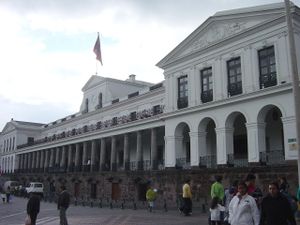
حقوق الإنسان
UN's Human Rights Council's (HRC) Universal Periodic Review (UPR) has treated the restrictions on freedom of expression and efforts to control NGOs and recommended that Ecuador should stop the criminal sanctions for the expression of opinions, and delay in implementing judicial reforms. Ecuador rejected the recommendation on decriminalization of libel.[35]
The laws also forbid articles and media messages that could favor or disfavor some political message or candidate. In the first half of 2012, twenty private TV or radio stations were closed down.[35]
In July 2012, the officials warned the judges that they would be sanctioned and possibly dismissed if they allowed the citizens to appeal to the protection of their constitutional rights against the state.[35]
People engaging in public protests against environmental and other issues are prosecuted for "terrorism and sabotage", which may lead to an eight-year prison sentence.[35]
العلاقات الخارجية
Ecuador's principal foreign policy objectives have traditionally included defense of its territory from external aggression and support for the objectives of the United Nations and the OAS. Ecuador's membership in the OPEC in the 1970s and 1980s allowed Ecuadorian leaders to exercise somewhat greater foreign policy autonomy. In Antarctica, Ecuador has maintained a peaceful research station for scientific study as a member nation of the Antarctica Treaty. Ecuador has often placed great emphasis on multilateral approaches to international issues. Ecuador is a member of the United Nations (and most of its specialized agencies) and a member of many regional groups, including the Rio Group, the Latin American Economic System, the Latin American Energy Organization, the Latin American Integration Association, the Bolivarian Alliance for the Peoples of Our America, the Andean Community of Nations, the Union of South American Nations (UNASUR), and the Bank of the South (Spanish: Banco del Sur or BancoSur).
The Ecuadorian government commits itself to upholding a progressive attitude towards migration related problems, declaring its Ministry of Foreign Affairs "Ministry of Foreign Affairs and Human Mobility" (Spanish: Ministerio de Relaciones Exteriores y Movilidad Humana). In 2017, the Ecuadorian parliament adopted a Law on human mobility.[36] In 2018, the ministry presented a new Human Mobility National Plan, based on policies aimed at promoting universal citizenship and free mobility in the international sphere; generate conditions to promote an orderly and safe migration, strengthen the protection of the rights of this population and defend its diversity, integration, and coexistence.
The International Organization for Migration lauds Ecuador as the first state to have established the promotion of the concept of universal citizenship in its constitution, aiming to promote the universal recognition and protection of the human rights of migrants.[37] In 2017, Ecuador signed the UN treaty on the Prohibition of Nuclear Weapons.[38]
التقسيمات الادارية
تنقسم الإكوادور إلى 24 مقاطعة (إسپانية: provincias)، كلٌ منها لها عاصمتها الادارية:

| مفتاح الخريطة | المقاطعة | العاصمة | التعداد (2022)[39] | المساحة (كم²) |
|---|---|---|---|---|
| 1 | كوِنكا | 888.000 | 8.189 | |
| 2 | جواراندا | 214.000 | 4.148 | |
| 3 | أزوجيس | 276.000 | 3.669 | |
| 4 | تولكان | 193.000 | 3.790 | |
| 5 | ريوبامبا | 531.000 | 5.999 | |
| 6 | لاتاكونجا | 496.000 | 6.085 | |
| 7 | ماتشالا | 722.000 | 5.879 | |
| 8 | إسمرالداس | 637.000 | 14.893 | |
| 9 | پورتو باكيريزو مورينو | 40.000 | 8.010 | |
| 10 | جواياكيل | 4.392.000 | 15.927 | |
| 11 | إبارا | 485.000 | 4.611 | |
| 12 | لوخا | 527.000 | 11.100 | |
| 13 | باباهويو | 932.000 | 7.100 | |
| 14 | پورتوڤييخو | 1.573.000 | 19.427 | |
| 15 | ماكاس | 203.000 | 25.690 | |
| 16 | تنا | 138.000 | 12.476 | |
| 17 | پوِرتو فرانسيسكو دى أوريانا | 167.000 | 21.691 | |
| 18 | پويو | 107.000 | 29.068 | |
| 19 | كيتو | 3.222.000 | 9.692 | |
| 20 | سانتا إلينا | 396.000 | 3.696 | |
| 21 | سانتو دومنجو | 464.000 | 4.180 | |
| 22 | نوڤا لوخا | 225.000 | 18.612 | |
| 23 | أمباتو | 603.000 | 3.222 | |
| 24 | زامورا | 114.000 | 10.556 | |
| الإجمالي | الإكوادور | كيتو | 17.545.000 | 283،561 متر كيلومربع (109،484 sq mi) |
1 التعداد حسب الإحصاء المُجرى في 2010-11-28[40]
تنقسم المقاطعات إلى كانتونات التي تنقسم بدورها إلى أبرشيات (parroquias).
المناطق ومناطق التخطيط
Regionalization, or zoning, is the union of two or more adjoining provinces in order to decentralize the administrative functions of the capital, Quito. In Ecuador, there are seven regions, or zones, each shaped by the following provinces:
- المنطقة 1 (42,126 كم²): Esmeraldas, Carchi, Imbabura, and Sucumbios. المدينة الادارية: Ibarra
- المنطقة 2 (43,498 كم²): Pichincha, Napo, and Orellana. المدينة الادارية: Tena
- المنطقة 3 (44,710 كم²): Chimborazo, Tungurahua, Pastaza, and Cotopaxi. المدينة الادارية: Riobamba
- المنطقة 4 (22,257 كم²): Manabí and Santo Domingo de los Tsachilas. المدينة الادارية: Ciudad Alfaro
- المنطقة 5 (38,420 كم²): Santa Elena, Guayas, Los Ríos, Galápagos, and Bolívar. المدينة الادارية: Milagro
- المنطقة 6 (38,237 كم²): Cañar, Azuay, and Morona Santiago. المدينة الادارية: Cuenca
- المنطقة 7 (27,571 كم²): El Oro, لوخا، و Zamora Chinchipe. المدينة الإدارية: لوخا
كيتو و گواياكيل are Metropolitan Districts. Galápagos, despite being included within Region 5,[41] is also under a special unit.[42]
القوات المسلحة
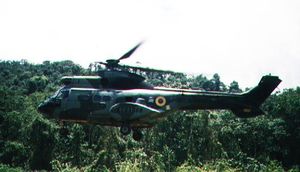

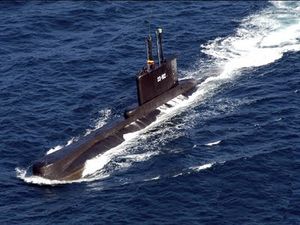
The Ecuadorian Armed Forces (Fuerzas Armadas de la Republica de Ecuador), consists of the Army, Air Force, and Navy and have the stated responsibility for the preservation of the integrity and national sovereignty of the national territory.
The military tradition starts in Gran Colombia, where a sizable army was stationed in Ecuador due to border disputes with Peru, which claimed territories under its political control when it was a Spanish vice-royalty. Once Gran Colombia was dissolved after the death of Simón Bolívar in 1830, Ecuador inherited the same border disputes and had the need of creating its own professional military force. So influential was the military in Ecuador in the early republican period that its first decade was under the control of General Juan José Flores, first president of Ecuador of Venezuelan origin. General Jose Ma. Urbina and General Robles are examples of military figures who became presidents of the country in the early republican period.
Due to the continuous border disputes with Peru, finally settled in the early 2000s, and due to the ongoing problem with the Colombian guerrilla insurgency infiltrating Amazonian provinces, the Ecuadorian Armed Forces has gone through a series of changes. In 2009, the new administration at the Defense Ministry launched a deep restructuring within the forces, increasing spending budget to $1,691,776,803, an increase of 25%.[43]
The icons of the Ecuadorian military forces are Marshall Antonio José de Sucre and General Eloy Alfaro. The Military Academy General Eloy Alfaro (c. 1838) graduates the army officers and is located in Quito.[44] The Ecuadorian Navy Academy (c. 1837), located in Salinas graduates the navy officers,[45] and the Air Academy "Cosme Rennella (c. 1920), also located in Salinas, graduates the air force officers.[46] Other training academies for different military specialties are found across the country.
الموقع
تحدها كولومبيا من الشمال، وبيرو من الشرق والجنوب، والمحيط الهادي من الغرب ، وأطول حدودها معجمهورية بيرو وكانت هذه الحدود مصدر اضطراب بين البلدين ، وهي قسم من جبال الأنديز ، وتشكل العمود الفقري للبلاد، وتمتد حوالي 640 كيلو متراً من الشمال إلى الجنوب ، وتتكون من سلسلتين جبليتين شرقية وغربية، وتحصر السلسلة سهلا يضم أحواضاً داخلية، والقسم الثاني من تضاريسها السهول الساحلية ويطل على المحيط الهادي، وتخلل التلال هذا القسم خصوصاً عند سفوح الأنديز.
الجغرافيا والمناخ
يتسم مناخها بالتناقض ، فالقسم الجبلي يتصف بالمناخ البارد ، حيث تنخفض الحرارة إلى درجة التجمد فوق قممها العالية ، وتسقط الأمطار فوق المرتفعات بين شهري نوفمبر ومايو ، وتنمو الغابات فوق السفوح المنخفضة ، تعلوها الحشائش ، ويسود النطاق الساحلي مناخ استوائي حار رطب ، وتسقط الأمطار الغزيرة في شمال هذا النطاق ، ويسود القسم الشرقي من البلاد مناح حار رطب.
التنوع الحيوي
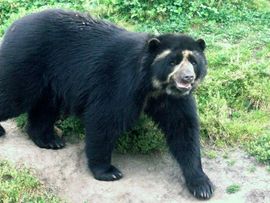
Ecuador is one of seventeen megadiverse countries in the world according to Conservation International,[47] and it has the most biodiversity per square kilometer of any nation.[48][49]
Ecuador has 1,600 bird species (15% of the world's known bird species) in the continental area and 38 more endemic in the Galápagos. In addition to over 16,000 species of plants, the country has 106 endemic reptiles, 138 endemic amphibians, and 6,000 species of butterfly. The Galápagos Islands are well known as a region of distinct fauna, famous as the place of birth of Darwin's Theory of Evolution and a UNESCO World Heritage Site.[50]
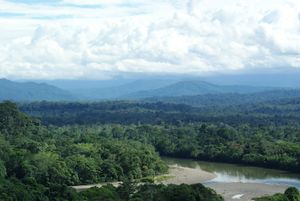
Ecuador has the first constitution to recognize the rights of nature.[51] The protection of the nation's biodiversity is an explicit national priority as stated in the National Plan of "Buen Vivir", or good living, Objective 4, "Guarantee the rights of nature", Policy 1: "Sustainably conserve and manage the natural heritage, including its land and marine biodiversity, which is considered a strategic sector".[48] As of the writing of the Plan in 2008, 19% of Ecuador's land area was in a protected area; however, the Plan also states that 32% of the land must be protected in order to truly preserve the nation's biodiversity.[48] Current protected areas include 11 national parks, 10 wildlife refuges, 9 ecological reserves, and other areas.[52] A program begun in 2008, Sociobosque, is preserving another 2.3% of total land area (6,295 km2, or 629,500 ha) by paying private landowners or community landowners (such as Amerindian tribes) incentives to maintain their land as native ecosystems such as native forests or grasslands. Eligibility and subsidy rates for this program are determined based on the poverty in the region, the number of hectares that will be protected, and the type of ecosystem of the land to be protected, among other factors.[53]
Despite being on the UNESCO list, the Galápagos are endangered by a range of negative environmental effects, threatening the existence of this exotic ecosystem.[54] Additionally, oil exploitation of the Amazon rainforest has led to the release of billions of gallons of untreated wastes, gas, and crude oil into the environment, contaminating ecosystems and causing detrimental health effects to Amerindian peoples.[55]
الاقتصاد
Ecuador has a developing economy that is highly dependent on commodities, namely petroleum and agricultural products. The country is classified as an upper-middle-income country. Ecuador's economy is the eighth largest in Latin America and experienced an average growth of 4.6% between 2000 and 2006.[56][المصدر لا يؤكد ذلك] From 2007 to 2012, Ecuador's GDP grew at an annual average of 4.3 percent, above the average for Latin America and the Caribbean, which was 3.5%, according to the United Nations' Economic Commission for Latin American and the Caribbean (ECLAC).[57] Ecuador was able to maintain relatively superior growth during the crisis. In January 2009, the Central Bank of Ecuador (BCE) put the 2010 growth forecast at 6.88%.[58] In 2011, its GDP grew at 8% and ranked 3rd highest in Latin America, behind Argentina (2nd) and Panama (1st).[59] Between 1999 and 2007, GDP doubled, reaching $65,490 million according to BCE.[60] The inflation rate until to January 2008, was about 1.14%, the highest in the past year, according to the government.[61][62] The monthly unemployment rate remained at about 6 and 8 percent from December 2007 until September 2008; however, it went up to about 9 percent in October and dropped again in November 2008 to 8 percent.[63] Unemployment mean annual rate for 2009 in Ecuador was 8.5% because the global economic crisis continued to affect the Latin American economies. From this point, unemployment rates started a downward trend: 7.6% in 2010, 6.0% in 2011, and 4.8% in 2012.[64]
The extreme poverty rate has declined significantly between 1999 and 2010.[65] In 2001, it was estimated at 40% of the population, while by 2011 the figure dropped to 17.4% of the total population.[66] This is explained to an extent by emigration and the economic stability achieved after adopting the U.S. dollar as official means of transaction (before 2000, the Ecuadorian sucre was prone to rampant inflation). However, starting in 2008, with the bad economic performance of the nations where most Ecuadorian emigrants work, the reduction of poverty has been realized through social spending, mainly in education and health.[67]
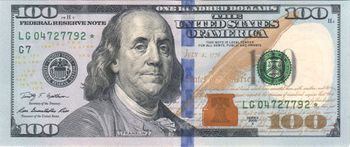
Oil accounts for 40% of exports and contributes to maintaining a positive trade balance.[68] Since the late 1960s, the exploitation of oil increased production, and proven reserves are estimated at 6.51 billion barrels اعتبارا من 2011[تحديث].[69]

The overall trade balance for August 2012 was a surplus of almost $390 million for the first six months of 2012, a huge figure compared with that of 2007, which reached only $5.7 million; the surplus had risen by about $425 million compared to 2006.[66] The oil trade balance positive had revenues of $3.295 million in 2008, while non-oil was negative, amounting to $2.842 million. The trade balance with the United States, Chile, the European Union, Bolivia, Peru, Brazil, and Mexico is positive. The trade balance with Argentina, Colombia, and Asia is negative.[70]
In the agricultural sector, Ecuador is a major exporter of bananas (first place worldwide in production and export), flowers, and the seventh largest producer of cocoa.[71] Ecuador also produces coffee, rice, potatoes, cassava (manioc, tapioca), plantains and sugarcane; cattle, sheep, pigs, beef, pork and dairy products; fish, and shrimp; and balsa wood.[72] The country's vast resources include large amounts of timber across the country, like eucalyptus and mangroves.[73] Pines and cedars are planted in the region of La Sierra and walnuts, rosemary, and balsa wood in the Guayas River Basin.[74] The industry is concentrated mainly in Guayaquil, the largest industrial center, and in Quito, where in recent years the industry has grown considerably. This city is also the largest business center of the country.[75] Industrial production is directed primarily to the domestic market.[بحاجة لمصدر] Despite this, there is limited export of products produced or processed industrially.[بحاجة لمصدر] These include canned foods, liquor, jewelry, furniture, and more.[بحاجة لمصدر] A minor industrial activity is also concentrated in Cuenca.[76] Incomes from tourism has been increasing during the last few years because of the Government showing the variety of climates and the biodiversity of Ecuador.
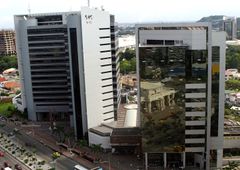
Ecuador has negotiated bilateral treaties with other countries, besides belonging to the Andean Community of Nations,[77] and an associate member of Mercosur.[78] It also serves on the World Trade Organization (WTO), in addition to the Inter-American Development Bank (IDB), World Bank, International Monetary Fund (IMF), Corporación Andina de Fomento (CAF) and other multilateral agencies.[79][80][81] In April 2007, Ecuador paid off its debt to the IMF, thus ending an era of interventionism of the Agency in the country.[82][83] The public finance of Ecuador consists of the Central Bank of Ecuador (BCE), the National Development Bank (BNF), the State Bank.
السكان
يشكل الهنود الأمريكيون حوالي 60% من سكان البلاد ، ويشكل المستيزو حوالي ثلث سكان البلاد ، وفي البلاد أقلية من الأسبان تعيش فوق المرتفعات ، واقلية زنجية تعيش في النطاق الساحلي ، ويعيش معظم السكان في النطاق المرتفع وحوالي 2% في القسم الشرقي من البلاد .
الأديان
الأمم
يعترف الدستور الإكوادوري بـ"تعدد الأمم" لأولئك الذين يريدون ممارسة انتماءهم لجماعات عرقية أصلية. ولذلك، فبالإضافة إلى الكريول criollos و المستيزو mestizos و الأفرو-إكوادوريين، فبعض الناس ينتمون إلى الأمم الأمريهنديين المتناثرة في بعض الأماكن على الساحل، وقرى كيتشوا الأنديزية وغابات الأمازون.
جينات السكان
According to a 2015 genealogical DNA testing, the average Ecuadorian is estimated to be 52.96% Native American, 41.77% European, and 5.26% Sub-Saharan African overall.[85]
الكثافة السكانية
The majority of Ecuadorians live in the central provinces, the Andes mountains, or along the Pacific coast. The tropical forest region to the east of the mountains (El Oriente) remains sparsely populated and contains only about 3% of the population. Birth rate is 2-1 for each death. Marriages are usually from 14 and above using parental consent. About 12.4% of the population is married in the ages 15–19. Divorce rates are moderate.
Population cities (2010)[86]
| أكبر مدن الإكوادور | ||||||||
|---|---|---|---|---|---|---|---|---|
 گواياكيل  كيتو |
المدينة | المقاطعة | التعداد |  كوِنكا  سانتو دومنگو | ||||
| 1 | گواياكيل | گواياس | 2 710 915 | |||||
| 2 | كيتو | پيچينچا | 2 342 191 | |||||
| 3 | كوِنكا | آزواي | 331 888 | |||||
| 4 | سانتو دومنگو | سانتو دومنگو دى لوس تساچيلاس | 305 632 | |||||
| 5 | ماتشالا | إل أورو | 241 606 | |||||
| 6 | دوران | گواياس | 235 769 | |||||
| 7 | پورتوڤييخو | مانابي | 223 086 | |||||
| 8 | مانتا | مانابي | 221 122 | |||||
| 9 | لوخا | لوخا | 180 617 | |||||
| 10 | أمباتو | تونگوراهوا | 178 538 | |||||
Status According to the 2010 Census[87]
Immigration and emigration
This section requires expansion. (August 2012) |
A small East Asian Latino community, estimated at 2,500, mainly consists of those of Japanese and Chinese descent, whose ancestors arrived as miners, farmhands and fishermen in the late 19th century.[2]
اللغة
Most Ecuadorians speak Spanish as their first language, with its ubiquity permeating and dominating most of the country, though there are many who speak an Amerindian language, such as Kichwa (also spelt Quichua), which is one of the Quechuan languages and is spoken by approximately 2.5 million people in Ecuador, Bolivia, Colombia, and Peru.[88] Other Amerindian languages spoken in Ecuador include Awapit (spoken by the Awá), A'ingae (spoken by the Cofan), Shuar Chicham (spoken by the Shuar), Achuar-Shiwiar (spoken by the Achuar and the Shiwiar), Cha'palaachi (spoken by the Chachi), Tsa'fiki (spoken by the Tsáchila), Paicoca (spoken by the Siona and Secoya), and Wao Tededeo (spoken by the Waorani). Use of these Amerindian languages are, however, gradually diminishing due to Spanish's widespread use in education. Though most features of Ecuadorian Spanish are universal to the Spanish-speaking world, there are several idiosyncrasies.
المطبخ
المطبخ الإكوادوري متنوع، varying with the altitude and associated agricultural conditions. Most regions in Ecuador follow the traditional three-course meal of soup, a course that includes rice and a protein, and then dessert and coffee to finish. Supper is usually lighter and sometimes consists only of coffee or herbal tea with bread.
النشاط البشري
الزراعة هي الحرفة الأولي، وتنقسم البلاد إلى نطاقين زراعيين، فالنطاق الساحلي والأراضي المنخقضة يشكلان نطاقاً تسود فيه المزارع المدارية، وتسوده حاصلات المناطق الحارة، حيث يزرع الأرز، والذرة، والموز ، والبن، والكاكاو ، والنطاق الثاني يسود المرتفعات حبث تزرع حاصلات المناطق المعتدلة مثل القمح ، والشعير ، والبطاطس ، وثروتها الحيوانية من الأبقار، والأغنام، ويبلغ الإنتاج السنوي من الأخشاب 4 ملايين من الأمتار المكعبة، ويعدن من أرضها الذهب ، والفضة، والنحاس، والرصاص، والزنك، ويستخرج الفحم والبترول .
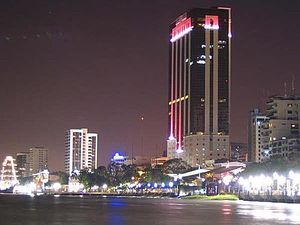
العرب في الإكوادور
وصل إلى سدة الحكم عدة رؤساء من أصل عربي، أشهرهم عبد الله بوكرم، الشهير ب "اللوكو" (أي المجنون) (1996 - 1997) و جميل معوض (1998 - 2000).
الدين

الاطعمة
الفن
وصلات خارجية
![]() تعريفات قاموسية في ويكاموس
تعريفات قاموسية في ويكاموس
![]() كتب من معرفة الكتب
كتب من معرفة الكتب
![]() اقتباسات من معرفة الاقتباس
اقتباسات من معرفة الاقتباس
![]() نصوص مصدرية من معرفة المصادر
نصوص مصدرية من معرفة المصادر
![]() صور و ملفات صوتية من كومونز
صور و ملفات صوتية من كومونز
![]() أخبار من معرفة الأخبار.
أخبار من معرفة الأخبار.
- President of Ecuador (بالإسپانية)
- الإكوادور at the Open Directory Project
- Wikia has a wiki on this subject: Ecuador
- الإكوادور travel guide from Wikitravel
 Wikimedia Atlas of Ecuador
Wikimedia Atlas of Ecuador- Pre-columbian Gold from Ecuador
- Pre-columbian Jade & Stone Artifacts from Ecuador
- ^ "Proyecciones Poblacionales". (in Spanish). National Institute of Statistics and Censuses (INEC). Archived from the original on 18 October 2013. Retrieved 25 April 2020.
- ^ أ ب خطأ استشهاد: وسم
<ref>غير صحيح؛ لا نص تم توفيره للمراجع المسماةCIA - ^ "Constitución Política de la República del Ecuador". Archived from the original on 17 October 2015. Retrieved 13 September 2014.
- ^ خطأ استشهاد: وسم
<ref>غير صحيح؛ لا نص تم توفيره للمراجع المسماةethn - ^ "Religion affiliations in Ecuador 2020".
- ^ España (1 January 1841). "Tratado de paz y amistad celebrado entre España y la República del Ecuador: en 16 de febrero de 1840". en la Imprenta Nacional. Archived from the original on 16 November 2016. Retrieved 25 July 2016 – via Google Books.
- ^ "Ecuador". Central Intelligence Agency. 27 February 2023 – via CIA.gov.
- ^ قالب:Cite CIA World Factbook
- ^ "Inicio". www.ecuadorencifras.gob.ec.
- ^ أ ب ت ث "World Economic Outlook Database, 30 November 2022". IMF.org. International Monetary Fund. October 2022. Retrieved October 11, 2022.
- ^ "Gini Index". World Bank. Retrieved 14 September 2022.
- ^ "Human Development Report 2021/2022" (PDF) (in الإنجليزية). United Nations Development Programme. 8 September 2022. Retrieved 8 September 2022.
- ^ "Constitución de la República del Ecuador en Shuar". Issuu. Archived from the original on أبريل 4, 2019. Retrieved فبراير 21, 2019.
- ^ "¡Iniuri seamkur!, Ayamrumamu nuyá Iniankasrik Ayamruma Papi" (PDF). INREDH. Archived (PDF) from the original on فبراير 21, 2019. Retrieved فبراير 21, 2019.
- ^ "Chicham atiakur metek atin turakur, pénke takakainiachu tuke enentaimtusartiniaitji" (PDF). (in Shuar). Secretaría Nacional de Planificación y Desarrollo. 2014. Archived from the original (PDF) on 2019-12-20.
- ^ Pellizzaro, Siro M.; Nàwech, Fàusto Oswaldo (2003). Chicham: Dictionario Enciclopédico Shuar-Castellano. Wea Nekaptai.
- ^ "Siri dice que la capital de Ecuador es Guayaquil, ¿qué pasó?". Retrieved أكتوبر 11, 2019.
- ^ "Quito se convirtió en la ciudad más poblada del Ecuador con más de 2,7 millones de habitantes en el 2018". Archived from the original on يناير 10, 2019. Retrieved يناير 11, 2019.
- ^ Lavilla, E.O. (2004). "Under the Southern Cross: Stories around Humboldt and Bonpland's trip to the New Continent" (PDF). Latin American Applied Research. 34: 203–208. Retrieved 22 August 2010.
- ^ "Ecuador en el día de la Independencia nacional". El Telégrafo (in الإسبانية الأوروبية). أغسطس 10, 2017. Archived from the original on أغسطس 8, 2018. Retrieved أغسطس 8, 2018.
- ^ "Assessment for Blacks in Ecuador". CIDCM. Archived from the original on June 22, 2012.
- ^ Roos, Wilma and van Renterghem, Omer Ecuador, New York, 2000, p.5.
- ^ أ ب "Uppsala Conflict Data Program - Conflict Encyclopedia, General Conflict Information, Conflict name: Ecuador - Peru, In depth, Background to the 1995 fighting and Ecuador and Peru engage in armed conflict". Archived from the original on سبتمبر 27, 2013. Retrieved يوليو 15, 2013.
- ^ Rory Carroll, Latin America correspondent (أكتوبر 1, 2010). "Ecuador's president attacked by police". The Guardian. London. Archived from the original on سبتمبر 17, 2013. Retrieved سبتمبر 12, 2011.
- ^ "Avenger against oligarchy" wins in Ecuador The Real News, April 27, 2009.
- ^ Romero, Simon (أبريل 27, 2009). "Ecuador Re-elects President, Preliminary Results Show". The New York Times. Archived from the original on يونيو 27, 2017. Retrieved فبراير 24, 2017.
- ^ "Most Popular E-mail Newsletter". USA Today. مايو 7, 2011. Archived from the original on سبتمبر 22, 2012. Retrieved أغسطس 26, 2017.
- ^ "Public spending fuels Ecuador leader's popularity". Voxxi.com. يناير 25, 2012. Archived from the original on مايو 12, 2013. Retrieved سبتمبر 4, 2012.
- ^ "Correa's and Ecuador's Success drive The Economist Nuts" Archived أبريل 16, 2015 at the Wayback Machine. New Economic Perspectives.
- ^
Correa wins re-election and says banks and mass media don't rule anymore Archived مارس 18, 2015 at the Wayback Machine. The Real News. February 19, 2013. Retrieved January 1, 2014.
- "Unemployment hit a record low of 4.1 percent at the end of last year. Poverty's down about 27 percent since he took office." - Mark Weisbrot, co-director of Center for Economic and Policy Research
- ^ "Équateur : Lenín Moreno et le néolibéralisme par surprise".
- ^ "Protesters move into Ecuador's capital; president moves out". ABC News. Retrieved 2019-10-10.
- ^ Kueffner, tephan (2019-10-10). "Ecuador Government Returns to Capital Amid National Strike". Bloomberg. Retrieved 2019-10-10.
- ^ "Compulsory Voting". Archived from the original on يونيو 12, 2009. Retrieved أغسطس 18, 2012.
- ^ أ ب ت ث "Ecuador". WORLD REPORT 2013, Human Rights Watch. pp. 1–3. Archived from the original on أكتوبر 6, 2014. Retrieved سبتمبر 13, 2014.
- ^ "Ley Orgánica de Movilidad Humana" (PDF). Archived (PDF) from the original on مارس 29, 2018. Retrieved أغسطس 28, 2018.
- ^ "Ecuador Launches New Human Mobility National Plan". يونيو 8, 2018. Archived from the original on أغسطس 28, 2018. Retrieved أغسطس 28, 2018.
- ^ "Chapter XXVI: Disarmament – No. 9 Treaty on the Prohibition of Nuclear Weapons". United Nations Treaty Collection. 7 July 2017.
- ^ La población corresponde al [1][dead link].
- ^ "Ecuador: Urban Places", https://www.citypopulation.de/php/ecuador,php, accessed 10 July 2017
- ^ "Niveles administrativos de planificación". Secretaría Nacional de Planificación y Desarrollo. Archived from the original on سبتمبر 24, 2015. Retrieved سبتمبر 24, 2015.
- ^ "Región 4 – Santo Domingo, Manabí y Galápagos". Ministry of Production, Employment and Competitiveness Coordination. Archived from the original on November 27, 2011. Retrieved February 20, 2012.
- ^ "Ecuador: A Comparative Atlas of Defence in Latin America / 2008 Edition". ccmr.org. Archived from the original on May 6, 2009. Retrieved June 26, 2010.
- ^ History of the "Escuela Superior Militar Eloy Alfaro" Archived يوليو 19, 2011 at the Wayback Machine
- ^ "Armada del Ecuador". Armada del Ecuador. Archived from the original on أكتوبر 10, 2017.
- ^ "History of the 'Escuela Superior Militar de Aviacion Cosme Rennella'". Esmafae.mil.ec. Archived from the original on ديسمبر 20, 2011. Retrieved فبراير 24, 2012.
- ^ "South America Banks on Regional Strategy to Safeguard Quarter of Earth's Biodiversity". Archived from the original on October 11, 2007. Retrieved July 26, 2012.
{{cite web}}: CS1 maint: bot: original URL status unknown (link), Conservation.org (September 16, 2003). - ^ أ ب ت Plan Nacional del Buen Vivir[dead link], Objective 4, Diagnostic, Section "La Biodiversidad y Patrimonio Natural", 2008 (Spanish)
- ^ "Ecuador – Biodiversity Conservation" (PDF). USAID. Archived from the original (PDF) on March 23, 2006.
- ^ "Unesco World Heritage". UNESCO. Archived from the original on سبتمبر 1, 2010. Retrieved يونيو 26, 2010.
- ^ "Ecuador's Constitution". Pdba.georgetown.edu. Archived from the original on فبراير 17, 2012. Retrieved فبراير 24, 2012.
- ^ Ministry of the environment of Ecuador, Protected Areas Archived مارس 25, 2012 at the Wayback Machine
- ^ Ministry of the environment, Sociobosque Program
- ^ Lemonick, Michael D. (October 30, 1995). "Time Magazine Report". Time. Archived from the original on February 4, 2013. Retrieved June 26, 2010.
- ^ San Sebastian, M.; Hurtig, A. K. (2004). "Oil Exploitation in the Amazon Basin of Ecuador: A Public Health Emergency". Pan American Journal of Public Health. 15 (3): 205–11. doi:10.1590/S1020-49892004000300014. PMID 15096294.
- ^ "Yahoo! Noticias España – Los titulares de hoy". Yahoo Noticias España. Archived from the original on سبتمبر 8, 2014. Retrieved سبتمبر 13, 2014.
- ^ Ecuador GDP Grew 4.3 Percent Average Per Year From 2007 to 2012 Archived نوفمبر 29, 2014 at the Wayback Machine. NAM News Network (NNN) (February 14, 2013). Retrieved April 24, 2013.
- ^ "El Banco Central de Ecuador sitúa el crecimiento del 2008 en más del 6%". soitu.es. Archived from the original on ديسمبر 15, 2014. Retrieved سبتمبر 13, 2014.
- ^ Producto Interno Bruto (PIB) - Tasa de Crecimiento Real (%) Archived يناير 24, 2013 at the Wayback Machine. Indexmundi.com. Retrieved January 28, 2013.
- ^ Banco Central del Ecuador – Resumen de pib Archived أكتوبر 29, 2012 at the Wayback Machine. Bce.fin.ec (July 11, 2012). Retrieved July 26, 2012.
- ^ "Ecuador Inflation rate (consumer prices) – Economy". Archived from the original on نوفمبر 29, 2014. Retrieved سبتمبر 13, 2014.
- ^ Gill, Nathan. (January 6, 2012) Ecuadorian Inflation Accelerated to Three-Year High in 2011 Archived فبراير 2, 2014 at the Wayback Machine. Bloomberg. Retrieved August 21, 2012.
- ^ "Ecuador en Cifras". Archived from the original on يونيو 16, 2013. Retrieved سبتمبر 13, 2014.
- ^ Comisión Económica para América Latina y el Caribe, CEPAL, Bases de Datos y Publicaciones Estadísticas "Tasa de desempleo." Archived مارس 18, 2015 at the Wayback Machine Retrieved on January 28, 2013.
- ^ "New Paper Examines Ecuador's Success in Emerging from Economic Recession; Reducing Poverty and Unemployment - Press Releases". Archived from the original on نوفمبر 11, 2014. Retrieved سبتمبر 13, 2014.
- ^ أ ب Rebeca, Ray and Sara, Kozameh. (May 2012) Ecuador's Economy Since 2007 Archived فبراير 2, 2014 at the Wayback Machine. p. 15.
- ^ "Ecuador". Archived from the original on يونيو 5, 2013. Retrieved سبتمبر 13, 2014.
- ^ "Ecuador first-half trade surplus rises to $390 mln - Energy & Oil-Reuters". Archived from the original on سبتمبر 28, 2014. Retrieved سبتمبر 13, 2014.
- ^ "Oil Reserves". Archived from the original on أكتوبر 2, 2014. Retrieved سبتمبر 13, 2014.
- ^ Ecuador: Evolucion de la Balanza Comercial Archived يونيو 17, 2012 at the Wayback Machine. Banco Central del Ecuador (January–February 2008).
- ^ "Downloads - Statistics – Production-Related Documents". Archived from the original on سبتمبر 20, 2014. Retrieved سبتمبر 13, 2014.
- ^ "The World Fact Book". Central Intelligence Agency [U.S.] Central Intelligence Agency [U.S.] Archived from the original on مارس 24, 2017. Retrieved مارس 30, 2017.
- ^ "Mapping for Results – Ecuador, Latin America & Caribbean". Archived from the original on فبراير 9, 2014. Retrieved سبتمبر 13, 2014.
- ^ Ecuador Facts, information, pictures | Encyclopedia.com articles about Ecuador Archived أغسطس 24, 2012 at the Wayback Machine. Encyclopedia.com. Retrieved September 14, 2012.
- ^ "Ranking 2010 – Ranking completo". Archived from the original on نوفمبر 17, 2014. Retrieved سبتمبر 13, 2014.
- ^ DUAL dmw. "Industrias en CUENCA". Archived from the original on أكتوبر 17, 2014. Retrieved سبتمبر 13, 2014.
- ^ South American Community Nations – Andean Community -CAN Archived يونيو 30, 2012 at the Wayback Machine. Comunidadandina.org. Retrieved August 21, 2012.
- ^ "Profile: Mercosur – Common Market of the South". Archived from the original on أكتوبر 10, 2014. Retrieved سبتمبر 13, 2014.
- ^ Which are its member countries? Archived يوليو 17, 2012 at the Wayback Machine aladi.org
- ^ "UNASUR (South American organization) – Britannica Online Encyclopedia". Archived from the original on أكتوبر 9, 2014. Retrieved سبتمبر 13, 2014.
{{cite web}}: Unknown parameter|encyclopedia=ignored (help) - ^ "Union of South American Nations". Archived from the original on يناير 25, 2015. Retrieved سبتمبر 13, 2014.
- ^ "Ecuador says pays off last debt with IMF". Reuters (in الإنجليزية). 2007-04-16. Retrieved 2020-02-03.
- ^ "Chapter 1: Ecuador's Illegitimate Debt". www.cadtm.org. Retrieved 2020-02-03.
- ^ أ ب ت "Central America and Caribbean :: PAPUA NEW GUINEA". CIA The World Factbook. Archived from the original on أبريل 10, 2011. Retrieved أغسطس 9, 2016.
- ^ Montinaro, F.; Busby, G. B.; Pascali, V. L.; Myers, S.; Hellenthal, G.; Capelli, C. (March 24, 2015). "Unravelling the hidden ancestry of American admixed populations". Nature Communications. 6. See Supplementary Data. doi:10.1038/ncomms7596. PMC 4374169. PMID 25803618.
- ^ خطأ استشهاد: وسم
<ref>غير صحيح؛ لا نص تم توفيره للمراجع المسماةcenso de 2010 - ^ "Resultados Nacionales Censo de Población y Vivienda". Inec.gob.ec. Archived from the original on فبراير 7, 2012. Retrieved فبراير 24, 2012.
- ^ Kichwa Kichwa language page
- Articles containing إسپانية-language text
- Articles containing إنگليزية-language text
- Pages using Lang-xx templates
- Pages using gadget WikiMiniAtlas
- Pages using infobox country or infobox former country with the symbol caption or type parameters
- Pages including recorded pronunciations
- Articles containing Quechua-language text
- Articles with hatnote templates targeting a nonexistent page
- Articles with unsourced statements from February 2009
- مقالات ذات عبارات بحاجة لمصادر
- مقالات فيها عبارات متقادمة منذ 2011
- جميع المقالات التي فيها عبارات متقادمة
- Articles with unsourced statements from August 2012
- Articles to be expanded from August 2012
- All articles to be expanded
- Pages with empty portal template
- الإكوادور
- مستعمرات إسپانية سابقة
- دول ناطقة بالاسبانية
- CS1: Julian–Gregorian uncertainty
- CS1 الإسبانية الأوروبية-language sources (es-es)
- Articles with dead external links from May 2020
- CS1 maint: bot: original URL status unknown
- Articles with dead external links from January 2017
- CS1 errors: unsupported parameter



